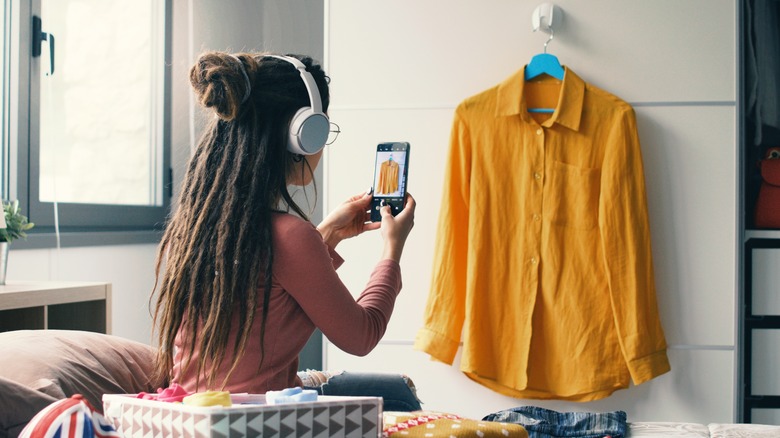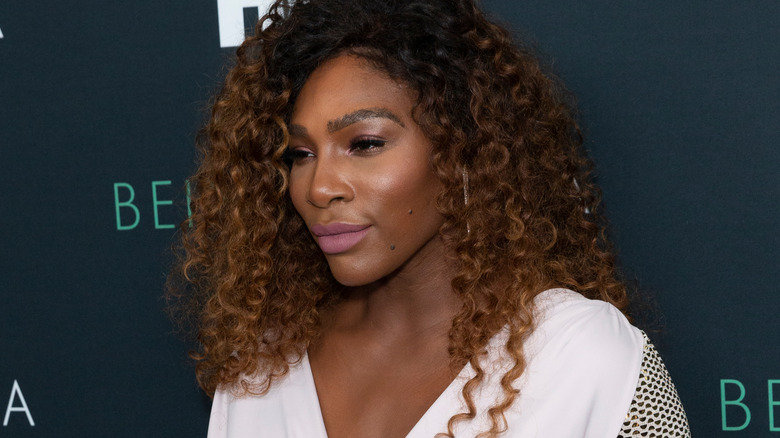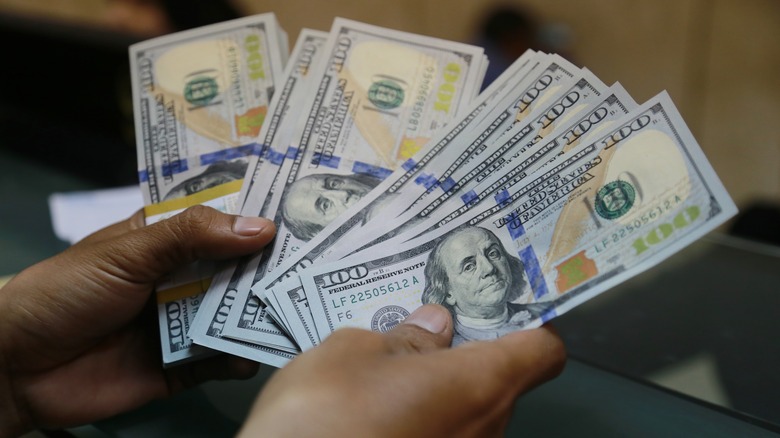Depop Vs. Poshmark: The Real Differences Between The Reselling Apps
Grabbing a few pieces of second-hand clothes is a great way to save money if you don't have a Kardashian-level wardrobe budget. However, that's not the only reason to spend your hard-earned cash on pre-loved items. Amanda Cosco, the founder of Electric Runway, told CBC in 2020, "Forever 21's collapse indicated that consumers are moving away from cheap thrills like trend pieces and towards choosing more durable, classic pieces that will stand the test of time."
Of course, Cosco also acknowledged that "scouring the racks at Value Village or your local thrift store requires time to sort through and try on items, as well as a good eye for your desired style." That's why she recommended another option, noting that "on apps and platforms, you can shop via your mobile phone." On top of that, she explained, "You can follow people who are your size and who represent the style you're aspiring to, so finding what you love is a lot easier." That's not to mention the fact that you can sell what you no longer want to make some extra cash.
That may make using online platforms to sell your clothes a simple choice and an option that you can't resist. At the same time, what's not straightforward may be what platform to use. For instance, what's the difference between Depop and Poshmark, two of the most popular reselling apps? We can fill you in on all of the necessary info so that you can decide which is best for you.
Shoppers on Poshmark and Depop are different
Whether you're interested in selling items online or are an eager shopper, it's best to know what kind of people use different platforms. This will not only help sellers reach ideal customers, but it also lets shoppers know that they're more likely to find treasures that suit them if they use a certain site. When it comes to Poshmark and Depop, users on both platforms obviously want to find awesome items and score a deal, but they're different in a few other ways.
"The shoppers on Poshmark are very diverse. There's all age groups, all genders, people with all types of styles," TikTok user @bryanmundjr explained. This means that you'll find a wide range of offerings on Poshmark. That's why @bryanmundjr noted that as a savvy seller, he lists "anything and everything on Poshmark." That includes "low-end brands, high-end mall brands, designer brands — anything on there will sell eventually if you price it accordingly."
On the other hand, @bryanmundjr said, "Buyers on [Depop] tend to be in their teens, 20s, and 30s." They are also "looking for specific types of item[s], mostly vintage and certain types of trends." Considering Depop only seems to attract a certain kind of user as opposed to Poshmark, which has a wider range, you might be curious about how many people actually use each option and which app has a larger audience.
Poshmark has millions of more users than Depop
There are a few ways that you could gauge how popular Poshmark is compared to Depop and vice versa. For instance, over on Twitter, Depop has more than 150,000 followers while Poshmark has over 154,000. When it comes to Instagram, there's an even bigger difference. Depop has over 717,000 followers and Poshmark has more than 1 million.
Of course, what surely matters the most is how many users are actually on each platform — the more users they have means that there will be more people listing pieces and more people to snap up what you might want to sell. Depop can boast about the fact that over 30 million individuals have signed up to use its service, according to Business of Apps. Specifically, they have around 1.8 million sellers along with 3.3 million buyers who are active and primarily based in the U.S., U.K., Australia, and Italy.
As for Poshmark, it has even more users. Like, a lot more users. Found mostly in the U.S., Canada, Australia, and India, there are around 80 million registered Poshmark users, per The Business of Business. Addressing the popularity, I Love Fashion Retail founder Sunny Netgains explained, "We find that our community of millions ... love the twice-daily push notifications we send so much that they end up taking a screenshot and posting to their social media profiles on Instagram and Twitter saying things like, 'Poshmark gets me.'"
Various celebrities sell on Depop and Poshmark
When celebrity stylist Karla Welch decided to pass on a few of the fabulous fashion finds she's collected over the years, she chose to use Poshmark. Welch, who is also the founder of The Period Company and Wishi, and has worked with stars like Justin Bieber and Olivia Wilde, told InStyle, "20 years of styling is a lot of time to accumulate a lot of pieces. I am also an avid collector, but if I hadn't touched some pieces in years, I thought it would be amazing to let them have another life with someone else."
Apparently, Welch isn't the only one in the entertainment scene who feels the same way. In fact, there's a fair share of celebrities who have jumped on the second-hand selling trend. On Poshmark, you can find Rachael Ray, Vanessa Hudgens, and Katherine Heigl, according to Closet Assistant. That's not to mention DJ Khaled, Ashton Kutcher, and Serena Williams.
Of course, Depop isn't doing too bad either when it comes to attracting famous figures to the platform. If you love what model Tess Holliday happens to wear, then you can take a peek at what she's selling on Depop, per Nylon. The same goes for Dita Von Teese, Doja Cat, Lily Allen, Maisie Williams, and Megan Thee Stallion, just to name a few of the fashionable celebs who are willing to sell you items from their own closet.
Poshmark and Depop opt for different fees
If you're interested in becoming a seller on Poshmark or Depop, then you should be aware of how they deal with fees. Frankly, they've each opted for a different method, which may sway your decision when it comes to which one to use.
Poshmark starts off with a flat fee, meaning that if you sell something that's listed for less than $15, they'll take $2.95. When you sell an item that's $15 or more, then they switch to a percentage and take 20% of the sale. The process of getting paid involves waiting until you ship off the item and it's received by the buyer on the other end. When that's done, you'll earn your money and can either withdraw it or keep it with the platform and spend it on Poshmark.
As for Depop, they stick with a 10% fee for all transactions no matter how big or little they might be. The way that the fee is charged depends on how you choose to sell. For instance, if you use PayPal, then the transaction is done using that account after the sale. However, the fee will be taken out before you receive your cut of the money if you opt to use Depop Payments. Whether you use PayPal or Depop Payments, you'll also face a transaction fee. You may need to do a little math to figure out if you'd rather fork over Poshmark or Depop's fees.




